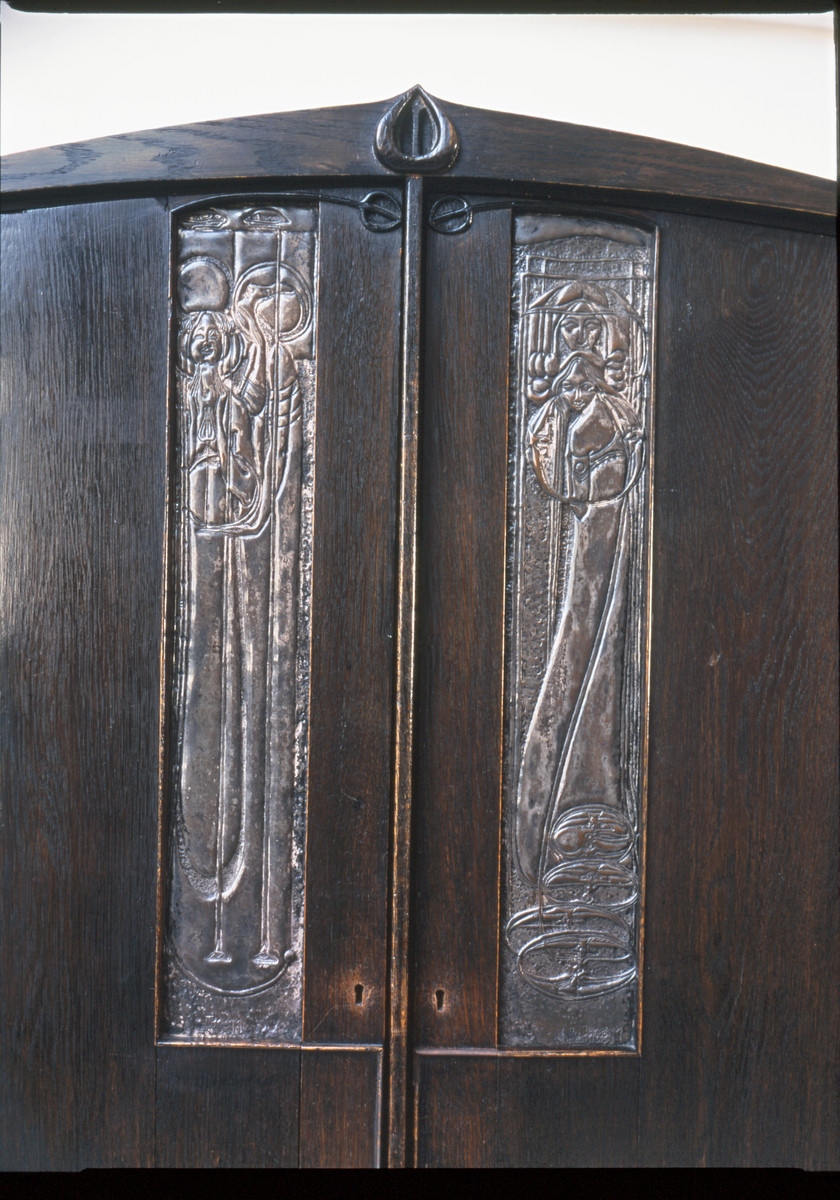The Glasgow Style
The Glasgow Style, as it has come to be called, may be seen as the Scottish manifestation of Art Nouveau. Less of a cohesive movement and more of a set of international styles, Art Nouveau expressed the diversity and ambiguity of the search for new forms in art, design, and architecture, c1890-1914. It arose from mid-19th century design reform movements – especially Arts and Crafts and Aestheticism in the United Kingdom – and like them fostered an ethos of unity in design.
Art Nouveau was referred to in French and Belgian artistic journals from the late 1870s; but the term was not popularised until 1895, when the German art dealer Siegfried Bing opened his gallery Maison de l’Art Nouveau in Paris. Like his British counterpart Arthur Lasenby Liberty, Bing had been an importer of Asian decorative arts since 1875 and launched the influential monthly journal Le Japon Artisitique in 1888. His new gallery featured interiors by the Belgian Henry van de Velde, with stained glass by the American Louis Comfort Tiffany.
This international aspect was a feature of Art Nouveau, as the style proliferated across the globe from North America to Australia, manifesting under the banners Jugenstil (Germany), Secession (Austria and Hungary), Stile Liberty (Italy), Modernisme (Catalonia), and of course, Glasgow Style. Whiplash curves and sinuous organic lines are its most familiar hallmarks; however, Art Nouveau is much more varied and complex, as Glasgow Style design and architecture shows.
These wide-ranging approaches were disseminated through international exhibitions, and periodicals such as The Studio, where several key artists associated with The Glasgow School of Art were featured in 1897-1898. Gleeson White, a friend of Francis Newbery, wrote a four-part series called ‘Some Glasgow Designers and their Work‘, which highlighted the work of Charles Rennie Mackintosh, Margaret Macdonald, Frances Macdonald, Herbert McNair, and Jessie Newbery. This brought international attention and cultivated invitations to show their work internationally, for example in the Eighth Vienna Secession exhibition (1900) and the Turin International Exhibition of Decorative Arts (1902).
Although a more traditional painter himself, Francis Newbery might be seen as an important driver of the Glasgow Style for bringing together a group of like-minded students he saw working in a similar style. Through activities such as the School of Art Club, they came together in shared creative practice to develop a common visual language. The Glasgow Style is characterised by stylised natural motifs. Flowers and plants – often roses, tulips, and thistles – are rendered in linear outline. Where rarely figures are depicted, an exaggerated elongation of form is used that marks the influence of Japanese art, and more directly, the illustrations of Aubrey Beardsley (examples of his Salome series appeared in the first issue of The Studio in 1894).
Beardsley was part of the literary and artistic movement known as Symbolism, which had a particular impact on Glasgow designers. Symbolist art offered suggestive ideas that were not necessarily explained clearly for the viewer but offered them the pleasure of rumination on their meaning through stylised and at times abstracted form. Some ideas also seem to be inspired by Celtic folklore but are largely drawn from imagination.
Early exploration of this style is readily seen in the student collective work The Magazine, full of literature and illustration that show their interest in fairy tales and Symbolism. Lettering, too, is often incorporated in designs that is quite distinct to the Glasgow Style, and has even come to be known as a ‘Mackintosh font’. However, it is possible that some of the earliest use of this lettering was by Jessie M. King, and we find it throughout GSA ephemera she and others designed for the School, as well as in unique items like this textile banner by Ann Macbeth. King also designed Glasgow Style book covers for the local publisher Blackie & Sons (for whom Mackintosh designed The Hill House); alongside Mackintosh and their friend Talwin Morris. GSA Library holds many of these examples in their special collections.
In terms of architecture, there are many examples of Mackintosh’s drawings in the collection, including the original designs for the presently ruined Mackintosh building, which were vital to its ongoing reconstruction, and will no doubt be instrumental again.
Key designers with Glasgow Style items in the Archives and Collections include: Janet Aitken, Katharine Cameron, Annie French, Jessie Keppie, Ann Macbeth, Jessie Marion King, Charles Rennie Mackintosh, Margaret Macdonald Mackintosh, Frances Macdonald MacNair, James Herbert MacNair, Daisy McGlashan, Grace Melvin, Francis Henry Newbery, Jessie Newbery, Agnes Raeburn, Lucy Raeburn, James Salmon, Dorothy Carleton Smyth and George Walton.
Further Reading
- Roger Billcliffe (2017): Charles Rennie Mackintosh and the Art of the Four, Frances Lincoln
- Alison Brown (2018): Charles Rennie Mackintosh: Making the Glasgow Style, Glasgow Museums
- William Buchanan (2004): Mackintosh's Masterwork: The Glasgow School of Art, Glasgow School of Art Press
- Jude Burkhauser (1990): Glasgow Girls: Women in Art and Design 1880-1920, Canongate Publishing Ltd., Edinburgh
- Annette Carruthers (2013): The Arts and Crafts Movement in Scotland: A History, Paul Mellon Centre for Studies in British Art
- Elizabeth Cumming (2006): Hand, Heart and Soul: The Arts and Crafts Movement in Scotland, Birlinn, Edinburgh
- Wendy Kaplan (1996): Charles Rennie Mackintosh (Catalogue of the Exhibition), Abbeville Press in association with Glasgow Museums, London
- Pamela Robertson, Hunterian Art Gallery - University of Glasgow and Walker Art Gallery (2006): Doves and Dreams: The Art of Frances Macdonald and J. Herbert McNair, Lund Humphries
- Gleeson White (July 1897): 'Some Glasgow Designers and Their Work (Part I)', The Studio 11, no. 52: 86–99
- Gleeson White (September 1897): 'Some Glasgow Designers and Their Work (Part II)', The Studio 11, no. 54: 227–236
- Gleeson White (October 1898): 'Some Glasgow Designers and Their Work (Part III)', The Studio 12, no. 55: 47–50
- Gleeson White (February 1898): 'Some Glasgow Designers and Their Work (Part IV)', The Studio 13, no. 59: 12–25


















